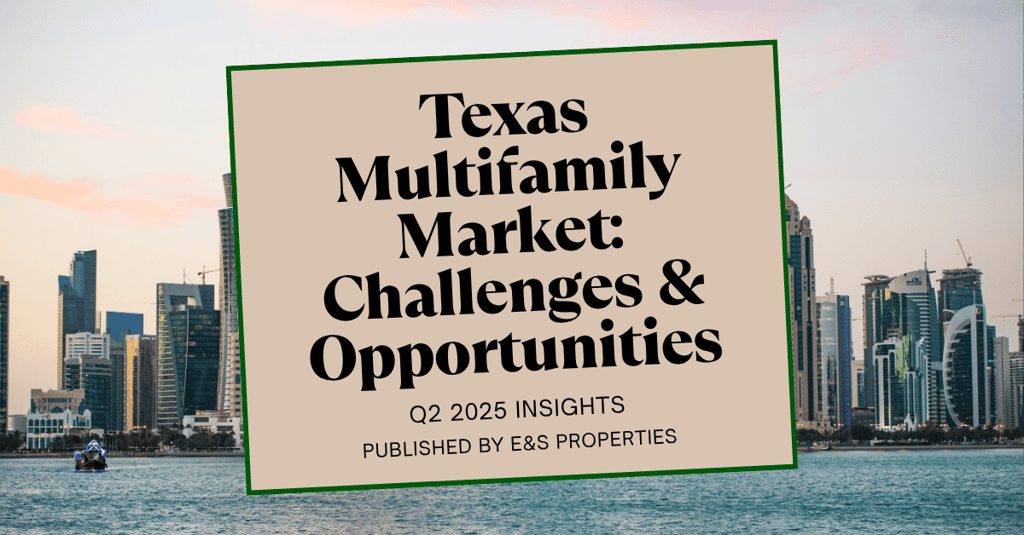Texas Multifamily Market Q2 2025: Oversupply Today, Opportunity Tomorrow for Value-Add Investors
Texas apartments face record vacancies and falling rents after years of heavy construction — but smart investors see a different story. Discover how the current oversupply cycle is creating high-yield value-add opportunities in Austin, DFW, Houston, and beyond.
10/29/20256 min read


Texas Multifamily Market Q2 2025: Oversupply Today, Opportunity Tomorrow for Value-Add Investors
Published by E&S Properties
Introduction: The Texas Market at an Inflection Point
The Texas multifamily market has long been one of the nation’s powerhouses — a magnet for population growth, business relocation, and institutional capital. Yet, as of the second quarter of 2025, even the Lone Star State isn’t immune to the challenges of a national supply surge.
Developers across Texas have delivered tens of thousands of new apartment units over the last two years, pushing vacancy rates higher and putting downward pressure on rents. For some, that sounds like trouble. For value-add investors, however, it’s the kind of dislocation that creates rare, strategic opportunities.
In this report, we’ll break down the latest data from Apartments.com’s Texas Market Trends Q2 2025 report, examine what’s driving the shift, and explore how these conditions can be leveraged by investors with a long-term, fundamentals-driven approach.
Statewide Snapshot: Supply Surge Meets Demand Cooldown
According to Apartments.com’s Q2 2025 data, every major Texas metro — Austin, Dallas–Fort Worth, Houston, and San Antonio — is dealing with the effects of record construction pipelines that began in 2021 through 2023. At the time, low interest rates, robust in-migration, and strong rent growth spurred a construction boom.
Fast-forward to 2025, and those projects have now hit the market just as absorption has cooled. The result: vacancies hovering between 11 and 14 percent statewide and rents declining or flat across most major metros.
That’s the near-term reality — but the long-term trajectory tells a different story. Construction starts have dropped sharply in 2024 and 2025, meaning the glut is finite. Once this current wave of deliveries is absorbed, Texas is poised for another rent-growth cycle—possibly as early as 2026.
Austin: The Epicenter of Oversupply
No market embodies the boom-to-plateau story quite like Austin.
Between 2021 and 2023, Austin approved and built one of the largest pipelines in the nation. Now, as those units lease up, asking rents are down roughly 4.3% year-over-year, marking the sixth straight quarter of negative rent growth. Vacancies are above 13%, and rent concessions are common.
For most developers, this is a cooling period. For value-add buyers, it’s the ideal entry window.
Why Value-Add Works in Austin Right Now
Distressed or fatigued owners: Many owners who developed at 2021-2022 cap rates are now facing high debt service at post-2023 interest levels. Some will be motivated sellers.
Quality inventory under pressure: Class A assets are being discounted to fill units, which compresses rents across B- and C-class stock — yet those older assets often need only cosmetic or amenity upgrades to compete.
Strong long-term fundamentals: Austin remains one of the top metros for tech and professional employment growth, with consistent net in-migration. When the supply wave subsides, the rebound could be sharp.
For operators who can modernize older B-class stock (interior finishes, smart-home retrofits, outdoor amenities), the rent delta between Class C and A will narrow again, creating room for stabilized yields above 7 percent.
San Antonio: Growth Meets Growing Pains
San Antonio’s story mirrors Austin’s — strong demographic growth and business inflows — but with a more moderate price base.
Vacancy climbed to ~14.3% in Q2, one of the highest in the state, as new inventory outpaced absorption. Still, population growth remains positive, and employment sectors like defense, healthcare, and manufacturing continue to expand.
Why San Antonio’s Weakness Is a Setup for Strength
Affordable entry pricing: Cap rates are meaningfully higher than Austin or DFW, often in the 7–8% stabilized range for B/C assets.
Room for operational improvement: Many mid-tier properties still lag in management efficiency, utility billing (RUBS), and rent optimization technology.
High concession pressure: Temporary rent discounts can be reversed once absorption normalizes, creating instant upside for disciplined operators.
A value-add investor acquiring today can ride out the short-term softness while implementing low-cost operational improvements — sub-metering, digital leasing tools, amenity enhancements — to create NOI growth ahead of the broader market recovery.
Dallas–Fort Worth: Texas’ Volume Leader
The DFW metroplex remains the largest apartment market in the state, with more than 27,000 units under construction in Q2 — the third-largest pipeline in the U.S. Rents slipped ~1.1% year-over-year, while vacancies rose to around 11.9%.
Despite the headline slowdown, DFW continues to attract companies relocating from coastal states, and its employment base remains remarkably diversified — finance, logistics, healthcare, tech, and manufacturing all contribute.
The Value-Add Angle in DFW
Scale and liquidity: Because of its size, DFW offers deep deal flow, giving investors more opportunities to find underperforming B/C assets in solid submarkets.
Operational efficiency: In a soft-rent environment, properties that streamline expenses and upgrade curb appeal can outperform their peers quickly.
Rent-to-income cushion: Even with mild rent declines, DFW’s rent-to-income ratio remains favorable, suggesting long-term affordability and resilience.
For investors, the DFW play isn’t about timing the absolute bottom — it’s about targeting assets with under-market rents and light-to-moderate renovation potential, then holding through the next cycle for compression and yield expansion.
Houston: The Steady Performer
Among Texas’ major metros, Houston stands out as the most balanced in Q2 2025. Although rent growth dipped slightly negative, Houston’s construction pipeline has slowed sharply, and absorption remains strong relative to new supply. Vacancy, at just above 11%, is actually an improvement from 2024 levels.
Houston benefits from a diverse economic base — energy, healthcare, port trade, and engineering — along with consistent job creation.
Why Houston Rewards Patient Capital
Less speculative supply: Developers have become cautious, so near-term oversupply risk is minimal.
Emerging submarkets: Areas like the Energy Corridor, Katy, and East Downtown are seeing targeted redevelopment, offering opportunities for repositioning C-class product into workforce housing.
Moderate rent levels: With average rents around $1.50 per sq. ft. — below the national average — Houston still has room for rent growth once the broader market tightens.
For value-add investors, Houston offers steady fundamentals with limited downside risk. Acquiring now, during a brief pricing lull, could produce outsized returns as concessions burn off and rent growth resumes by early 2026.
Secondary and Tertiary Markets: Hidden Bright Spots
While the big four metros dominate headlines, several smaller Texas markets are quietly outperforming. Cities with inventories under 20,000 units — such as Abilene (+7.8% YOY rent growth) and Midland-Odessa (+3–4%) — show that local economic anchors (education, energy, logistics) continue to sustain demand.
For value-add investors, these smaller metros offer distinct advantages:
Less institutional competition and therefore better pricing power.
Tighter supply constraints, reducing exposure to oversupply risk.
Cap rates that are 100–200 basis points higher than the primary markets.
Operators who know how to manage remotely or partner with strong local property managers can tap these regions for above-average yield and diversification.
The Macro Outlook: When the Cycle Turns
Apartments.com projects that all major Texas markets will return to positive rent growth by late 2026, with Houston leading, followed by DFW, then San Antonio and Austin.
That timeline aligns with a few key macro trends:
Construction starts have fallen sharply since 2024, which will slow new deliveries by 2026.
Population growth remains strong, especially among young professionals and retirees relocating from higher-cost states.
Interest-rate normalization is expected to resume in 2026, improving transaction velocity and refinancing options.
Taken together, these dynamics set the stage for a classic recovery cycle: rents stabilize, concessions taper, and buyers who acquired in 2024–2025 see value appreciation through both cap-rate compression and rising NOI.
Strategic Takeaways for Value-Add Investors
1. Focus on Underperforming Assets, Not Distressed Ones
The goal isn’t to chase the cheapest property; it’s to find the right inefficiencies. A 1980s B-class building in a solid submarket, suffering from poor management or cosmetic neglect, offers a much clearer path to forced appreciation than a half-vacant C-class in a declining area.
2. Target Submarkets with Job Drivers and Supply Limits
Look for neighborhoods anchored by hospitals, universities, and logistics hubs where new construction is limited by zoning or land scarcity. Examples include Katy (Houston), Round Rock (Austin MSA), Irving (DFW), and Alamo Heights (San Antonio).
3. Use Conservative Stabilization Assumptions
Model stabilized cap rates at 1.5 to 3.0 points below the current purchase cap, reflecting long-term equilibrium. Build in adequate reserves for operating expenses and financing volatility.
4. Implement Revenue-Focused Upgrades
Instead of large-scale gut rehabs, prioritize improvements that directly increase rent or retention:
In-unit washer/dryer additions
Fitness and co-working areas
Smart-lock and thermostat upgrades
Shared outdoor spaces and EV charging stations
5. Prepare for a 2026 Upswing
Properties acquired and repositioned in 2025 should be fully stabilized by the time rent growth resumes, enabling refinancing or partial equity recapture during the next expansion phase.
E&S Properties’ View: Opportunity in the Volatility
At E&S Properties, we see the current Texas multifamily slowdown not as a red flag but as a strategic opening. Oversupply has created a temporary disconnect between asset value and intrinsic market strength.
By focusing on value-add assets with strong bones, capable management, and clear operational inefficiencies, we can bridge that gap — creating yield today and appreciation tomorrow.
Our approach remains consistent:
Acquire below replacement cost.
Implement targeted renovations and efficiency upgrades.
Re-tenant intelligently with modern marketing and digital leasing tools.
Refinance or dispose when stabilization yields meet or exceed our 20% IRR target.
In markets like Houston, DFW, and secondary metros across the state, we believe the next 12–18 months represent a rare window for disciplined investors to enter high-growth regions at favorable pricing.
Conclusion: The Path from Oversupply to Opportunity
The Q2 2025 Texas Multifamily Report paints a clear picture: the boom of yesterday created the softness of today. But for investors who understand market cycles, that softness is precisely what creates value-add upside.
Texas remains the growth engine of the United States — its population, job base, and business climate continue to outperform the nation. The short-term oversupply is not structural weakness; it’s the lagging effect of extraordinary demand from years past.
For the patient, data-driven investor, this is the time to position capital, not retreat. As supply burns off and rents stabilize through 2026, today’s acquisitions will become tomorrow’s outperformers.
🔎 Ready to take the next step?
📩 Sign up for our newsletter to get weekly insights on current trends.
📝 Interested in investing? Complete our investor questionnaire and we’ll be in touch with opportunities that match your goals.
